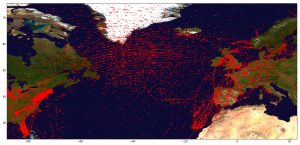
An image shows aircraft tracked by the CanX-7 ADS-B payload over the North Atlantic from October 2016 to March 2017. (Credit: SFL)
The CanX-7 nanosatellite built by Space Flight Laboratory (SFL) at the University of Toronto Institute for Aerospace Studies validated real-time detection and tracking of aircraft by a satellite in low-Earth orbit. The next mission phase will begin in early May 2017 with deployment of drag sails developed by SFL to accelerate the deorbiting of small satellites as a practical solution to the space-debris problem.
SFL developed CanX-7 on its space-proven nanosatellite bus carrying two payloads: the Automatic Dependent Surveillance—Broadcast (ADS-B) aircraft tracking receiver manufactured by the Royal Military College of Canada (with support from SFL) and the modular drag sail system. Measuring 10 by 10 by 34 centimeters, the 3.5-kilogram nanosat was launched on Sept. 26, 2016, from India.
“The ADS-B instrument on CanX-7 has received and decoded 3.6 million signals from aircraft in less than six months,” said Dr. Robert E. Zee, SFL director. “This mission proves that global real-time aircraft tracking can be achieved with a low-cost, responsive constellation of small satellites.”
After the ADS-B validation is completed, the deorbit demonstration will be initiated, contributing to Canada’s cooperation with the Inter-Agency Debris Coordination Committee, which has released guidelines on satellite deorbit measures to mitigate orbital debris problems.
“This is the first drag sail deorbit technology developed and launched by Canada,” added Zee. “The modular design will enable this system to deorbit almost any small satellite up to 100 kilograms in mass.”
The four one-square-meter sails will be deployed sequentially with commands from the SFL ground station in Toronto, and onboard sensors will monitor their deployment. The sails will increase drag on the satellite and accelerate orbital decay over a few years to the point where it will burn up in the atmosphere. Without the potential use of sail technology, some small satellites could stay in low-Earth orbit for more than 25 years, posing collision risks to other low-Earth satellites and the International Space Station.